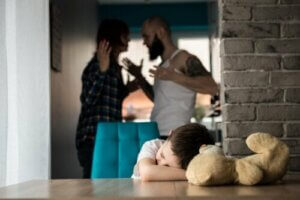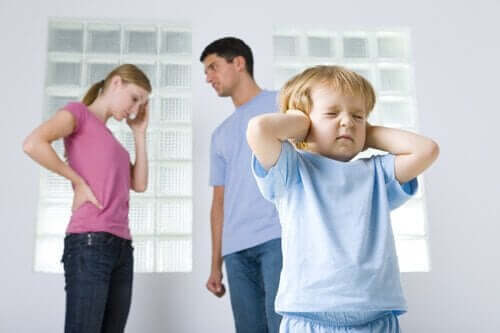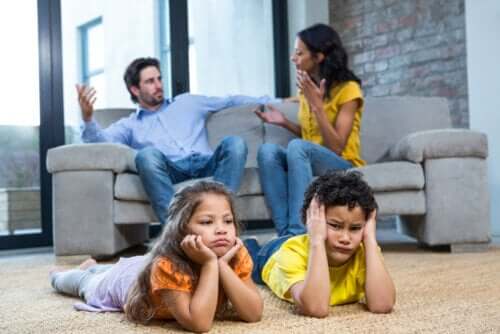Different Types of Dysfunctional Families


Written and verified by the psychologist Elena Sanz Martín
At some point, we’ve all talked about dysfunctional families, when describing ones that seem to be chaotic or harmful. However, even though they may share similar traits, there are different types of dysfunctional families, from different origins.
In today’s article, we’ll talk about the characteristics and possible causes of dysfunctional families. Bearing this in mind will help us identify risky behaviors, and ask for help, in case we have to.
What are the functions of the family?
Before talking about dysfunctional families, let’s describe the functions of a healthy family:
- Cohesion: physical and emotional union among members. They spend time together and support each other. They also make joint decisions.
- Harmony: they respect each other’s interests and needs.
- Communication: parents and their children are able to express their emotions and opinions in a clear and respectful way.
- Affectivity: they’re all able to feel and express positive emotions towards the rest of the family members, using words or physical contact.

- Roles: the roles of the different members are well defined, and they all fulfill their functions. Parents are parents, and children are children.
- Adaptability: the family members’ ability to change roles or rules whenever a situation requires them to. For example, if the mother is always in charge of making dinner, another member should also be able to make it, in case she feels ill, for example.
What are dysfunctional families?
We can talk about dysfunctional families whenever one of the previously mentioned elements is unbalanced. When there’s no union or affectivity, when roles aren’t well defined or they’re too rigid, we’re in the presence of dysfunctional families.
Another characteristic of dysfunctional families is lack of communication or talking to each other in an aggressive or harmful manner. All in all, a healthy family is the one which finds balance. When something is missing or other things are excessive, families stop serving their functions.
Different types of dysfunctional families
There are many different types of dysfunctional families, and the origin of their problems isn’t always the same. In addition, it isn’t always the same family member who shows improper behavior. The following are the most common situations:
- Addictions: this occurs when a family member has an addiction. The cause of their addiction can be different legal substances (tobacco, alcohol, etc.), or illegal substances. Furthermore, people can become addicted to the TV, food or even the internet. In all of these cases, addictive behaviors affect the rest of the family members.
- Mental disorders: some people suffer from psychological disorders, such as antisocial disorder, depression, bipolar disorder, etc. Besides causing serious damages in the family functioning, some family members may feel embarrassed by this situation. Therefore, sometimes, families tend to isolate and hide what goes on in their family. In other occasions, family members may run away from their homes, as soon as they have the chance to.

- Abuse: this occurs when there’s abuse of any kind within the family environment. The abuse can be physical, sexual or psychological. In fact, psychological abuse is the most common type, including manipulation, threats and verbal aggression.
- Unreality: this happens when one of the family members denies reality. Family might be facing a big problem (abuse, crimes, etc.), but this person refuses to admit it. They look for excuses and deny accusations. As a result, the problem gets bigger.
Team work in dysfunctional families
Even though the main problem might be caused by only one of the family members, it affects the whole family. Therefore, it’s important to work as a team. When you realize you’re part of a dysfunctional family, it’s important to identify the signs and take responsibility. At that point, you should ask for help.
On the other hand, denying the problem, hiding it or isolating from the rest of the people will only make the situation worse. Even if one of the members refuses to get help, it might be positive for the rest of the family. Finally, a family must be a shelter of love and security, so everyone involved should be able to identify and solve the problems that may arise.
At some point, we’ve all talked about dysfunctional families, when describing ones that seem to be chaotic or harmful. However, even though they may share similar traits, there are different types of dysfunctional families, from different origins.
In today’s article, we’ll talk about the characteristics and possible causes of dysfunctional families. Bearing this in mind will help us identify risky behaviors, and ask for help, in case we have to.
What are the functions of the family?
Before talking about dysfunctional families, let’s describe the functions of a healthy family:
- Cohesion: physical and emotional union among members. They spend time together and support each other. They also make joint decisions.
- Harmony: they respect each other’s interests and needs.
- Communication: parents and their children are able to express their emotions and opinions in a clear and respectful way.
- Affectivity: they’re all able to feel and express positive emotions towards the rest of the family members, using words or physical contact.

- Roles: the roles of the different members are well defined, and they all fulfill their functions. Parents are parents, and children are children.
- Adaptability: the family members’ ability to change roles or rules whenever a situation requires them to. For example, if the mother is always in charge of making dinner, another member should also be able to make it, in case she feels ill, for example.
What are dysfunctional families?
We can talk about dysfunctional families whenever one of the previously mentioned elements is unbalanced. When there’s no union or affectivity, when roles aren’t well defined or they’re too rigid, we’re in the presence of dysfunctional families.
Another characteristic of dysfunctional families is lack of communication or talking to each other in an aggressive or harmful manner. All in all, a healthy family is the one which finds balance. When something is missing or other things are excessive, families stop serving their functions.
Different types of dysfunctional families
There are many different types of dysfunctional families, and the origin of their problems isn’t always the same. In addition, it isn’t always the same family member who shows improper behavior. The following are the most common situations:
- Addictions: this occurs when a family member has an addiction. The cause of their addiction can be different legal substances (tobacco, alcohol, etc.), or illegal substances. Furthermore, people can become addicted to the TV, food or even the internet. In all of these cases, addictive behaviors affect the rest of the family members.
- Mental disorders: some people suffer from psychological disorders, such as antisocial disorder, depression, bipolar disorder, etc. Besides causing serious damages in the family functioning, some family members may feel embarrassed by this situation. Therefore, sometimes, families tend to isolate and hide what goes on in their family. In other occasions, family members may run away from their homes, as soon as they have the chance to.

- Abuse: this occurs when there’s abuse of any kind within the family environment. The abuse can be physical, sexual or psychological. In fact, psychological abuse is the most common type, including manipulation, threats and verbal aggression.
- Unreality: this happens when one of the family members denies reality. Family might be facing a big problem (abuse, crimes, etc.), but this person refuses to admit it. They look for excuses and deny accusations. As a result, the problem gets bigger.
Team work in dysfunctional families
Even though the main problem might be caused by only one of the family members, it affects the whole family. Therefore, it’s important to work as a team. When you realize you’re part of a dysfunctional family, it’s important to identify the signs and take responsibility. At that point, you should ask for help.
On the other hand, denying the problem, hiding it or isolating from the rest of the people will only make the situation worse. Even if one of the members refuses to get help, it might be positive for the rest of the family. Finally, a family must be a shelter of love and security, so everyone involved should be able to identify and solve the problems that may arise.
All cited sources were thoroughly reviewed by our team to ensure their quality, reliability, currency, and validity. The bibliography of this article was considered reliable and of academic or scientific accuracy.
- Enriquez Ludeña, R. L., Pérez Cabrejos, R. G., Ortiz Gonzales, R., Cornejo Jurado, Y. C., & Chumpitaz Caycho, H. E. (2021). Disfuncionalidad familiar y depresión del adolescente: una revisión sistemática entre los años 2016-2020. Conrado, 17(80), 277-282. http://scielo.sld.cu/scielo.php?pid=S1990-86442021000300277&script=sci_arttext&tlng=pt
- Gómez Arroba, O. J. (2014). Las familias disfuncionales y su influencia en el consumo de alcohol de los estudiantes del Colegio Reinaldo Miño Altamirano de la Parroquia Santa Rosa, Cantón Ambato en el periodo agosto 2012–enero 2013 (Bachelor’s thesis). https://repositorio.uta.edu.ec/bitstream/123456789/6620/1/Orlando%20Javier%20Gomez%20Arroba.pdf
- Murillo Flores, D. G. (2012). De qué manera la familia disfuncional es factor de riesgo para sufrir abuso sexual infantil. http://www.dspace.uce.edu.ec/handle/25000/2017
- Padrón, R. I. V. (2018). La disfuncionalidad familiar una condicionante para la adicción al alcoholismo en adolescentes y jóvenes. Anuario Ciencia en la UNAH, 16(1). https://rcta.unah.edu.cu/index.php/ACUNAH/article/view/1092
- Rivadeneira Samaniego, G. N., & Trelles López, L. M. (2013). Incidencia de las familias disfuncionales en el proceso de la formación integral en los niños del sexto año de educación básica de la unidad educativa republica del ecuador, canton huamboya, provincia de morona Santiago (Bachelor’s thesis). https://dspace.ups.edu.ec/bitstream/123456789/6086/1/UPS-CT002821.pdf
This text is provided for informational purposes only and does not replace consultation with a professional. If in doubt, consult your specialist.








